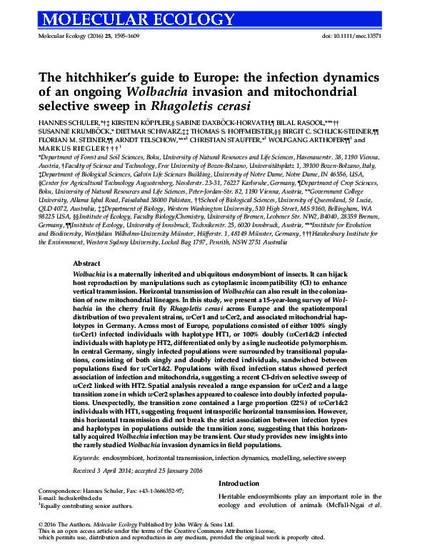
- horizontal transmission,
- infection dynamics,
- modelling,
- selective sweep
Wolbachia is a maternally inherited and ubiquitous endosymbiont of insects. It can hijack host reproduction by manipulations such as cytoplasmic incompatibility (CI) to enhance vertical transmission. Horizontal transmission of Wolbachia can also result in the colonization of new mitochondrial lineages. In this study, we present a 15-year-long survey of Wolbachia in the cherry fruit fly Rhagoletis cerasi across Europe and the spatiotemporal distribution of two prevalent strains, wCer1 and wCer2, and associated mitochondrial haplotypes in Germany. Across most of Europe, populations consisted of either 100% singly (wCer1) infected individuals with haplotype HT1, or 100% doubly (wCer1&2) infected individuals with haplotype HT2, differentiated only by a single nucleotide polymorphism. In central Germany, singly infected populations were surrounded by transitional populations, consisting of both singly and doubly infected individuals, sandwiched between populations fixed for wCer1&2. Populations with fixed infection status showed perfect association of infection and mitochondria, suggesting a recent CI-driven selective sweep of wCer2 linked with HT2. Spatial analysis revealed a range expansion for wCer2 and a large transition zone in which wCer2 splashes appeared to coalesce into doubly infected populations. Unexpectedly, the transition zone contained a large proportion (22%) of wCer1&2 individuals with HT1, suggesting frequent intraspecific horizontal transmission. However, this horizontal transmission did not break the strict association between infection types and haplotypes in populations outside the transition zone, suggesting that this horizontally acquired Wolbachiainfection may be transient. Our study provides new insights into the rarely studied Wolbachia invasion dynamics in field populations.
